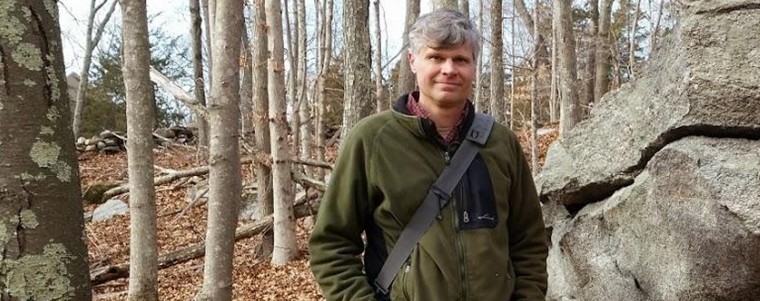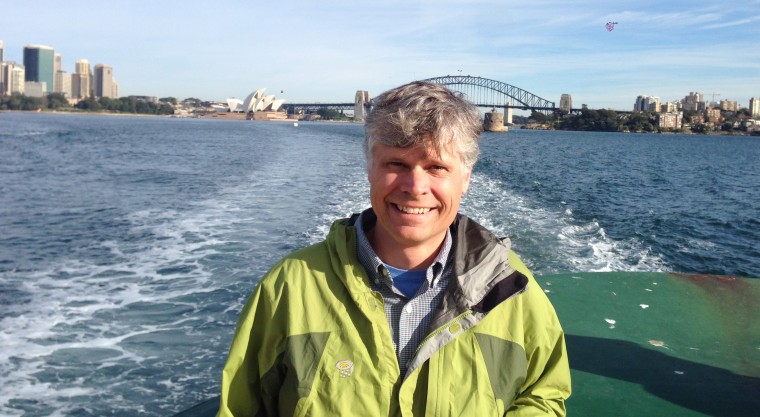Wesleyan's Board of Trustees recently announced the promotions of nine faculty members, effective July 1, 2020. Five faculty were conferred tenure with promotion. They join six other faculty members who were awarded tenure earlier this spring. Joslyn Barnhart Trager, associate professor of government Anthony Keats, associate professor of economics Andrew Quintman, associate professor of religion Michael Slowik '03, associate professor of film studies Takeshi Watanabe, associate professor of East Asian studies In addition, four faculty members are being promoted. They join one other faculty member who was promoted earlier this spring. Erika Franklin Fowler, professor of government Barbara Juhasz, professor…
On Nov. 18, the Department of Earth and Environmental Sciences (E&ES) hosted the 8th Annual Meeting of the Geological Society of Connecticut (GSC). The event featured a student scholarship wine-tasting fundraiser and a public science lecture called “The Real Jurassic Park in the Connecticut Valley,” by paleontologist Robbert Baker. During the meeting, Phillip Resor, associate professor of earth and environmental sciences, Martha “Marty” Gilmore, the George I. Seney Professor of Geology, were awarded the Joe Webb Peoples Award for their efforts in hosting the 2015 New England Intercollegiate Geologic Conference. The award recognizes those who have contributed to the understanding…
Phil Resor, associate professor of earth and environmental sciences, and Gus Seixas '10 are co-authors of "Constraints on the evolution of vertical deformation and Colorado River incision near eastern Lake Mead, Arizona, provided by quantitative structural mapping of the Hualapai Limestone," published in the February 2015 issue of Geosphere, Vol. 11, pages 31-49. The paper includes research from Seixas's honors thesis at Wesleyan. In this study, the authors quantify the structural geometry of Hualapai Limestone, which was deposited in a series of basins that lie in the path of the Colorado River. The limestone was deformed by by a fault pair…
Phillip Resor, associate professor of earth and environmental sciences, was recently interviewed on WNPR about an amazing part of Connecticut's geological history. According to the story, several hundred million years ago, Connecticut was in the middle of a massive continental collision, which formed the super continent Pangea and pushed up huge mountains. Deep beneath the earth, a borderland beneath the two continents formed. Today, geologists call it the Lake Char fault system; it runs along the I-395 corridor in southeastern Connecticut. Resor took WNPR reporter Patrick Skahill to East Haddam by Gillette Castle to walk along the banks of the Connecticut River, and showed him fine black…
Philip Resor, associate professor of earth and environmental sciences, is taking his knowledge of petroleum down under. Between June 18-26, Resor, a Distinguished Lecturer for the American Association of Petroleum Geologists (AAPG), is delivering six lectures in Australia. The talks are geared toward members of the Petroleum Exploration Society of Australia (PESA) and a general petroleum industry audience. While abroad, Resor will speak on "Syndepositional Faulting of Carbonate Platforms" and "Revisiting the Origin of Reverse Drag." He'll be lecturing in Melbourne, Adelaide, Perth, Brisbane, Sydney and Canberra. A specialist in structural geology, Resor's work integrates field mapping, remote sensing, and numerical modeling to better understand the…
Kate Shervais '13 presented her thesis research on "Examining Microroughness Evolution in Natural and Experimental Pseudotachylyte-bearing Fault Surfaces," at the European Geosciences Union General Assembly in April. More than 11,000 scientists from 95 countries attended the conference, which was held in Vienna, Austria. Only 28 percent of the participants were students. Shervais completed her study with Phil Resor, associate professor of earth and environmental sciences. Resor, who received a National Science Foundation grant to study earthquakes in an Italian fault zone, also attended the conference. The NSF grant supported their travel to the conference. "I had a wonderful time and…
A new study designed to give scientists a better understanding of how earthquakes occur by studying ancient faults long after the quakes are over will be led by a Wesleyan faculty member and involve at least two of his students. Phillip Resor, assistant professor of earth and environmental sciences, received a $246,728 NSF (National Science Foundation) grant for his study titled “Three Dimensional Characterization of a Pseudotachylyte-bearing Fault.” The grant includes funding for one thesis student for each of the next two years; Wesleyan has contributed additional funding for a second student in 2012. The study will also establish a…
Phil Resor, assistant professor of earth and environmental sciences, received a $246,728 grant from the National Science Foundation for his study on "Three Dimensional Characterization of a Pseudotachylyte-bearing Fault." The grant was awarded on March 15 and expires on June 30, 2014. In this study, Resor and Wesleyan students will use high-resolution x-ray computed tomography imagery of natural and experimental fault surfaces to quantify surface roughness, frictional contact area, and Pseudotachylyte fault rock thickness. "Pseudotachylytes are generally considered the only unequivocal evidence of earthquake slip velocities that is preserved in fault zones," Resor explains. The proposed project will improve the…
Three faculty members from Earth and Environmental Sciences, as well as two graduate students and two undergraduate students, presented their research at the annual conference of the American Geophysical Union (AGU) in San Francisco, Calif., Dec. 5-7. The conference drew more than 20,000 scientists and policy makers from around the world. Associate Professors Suzanne O’Connell and Dana Royer, Assistant Professor Phillip Resor, and Austin Reed MA-candidate, Rosemary Ostfeld BA ‘10/MA ‘12, and Julia Mulhern ’12 all attended. In addition, a poster by Katherine Shervais ’13, was also presented. “Our research in the Department of Earth and Environmental Sciences is so…
(more…)
This semester, 18 earth and environmental sciences majors explored dwarf mangrove forests, studied landslide susceptibility in a rainforest, examined if cave rocks record bat inhabitation, and analyzed the chemistry of coastal seagrass – all in Puerto Rico. The students, who are enrolled in the E&ES 398 course Senior Seminar, developed observational, interpretative and research skills through their island studies. The seniors traveled to Puerto Rico in January for fieldwork, and spent the past few months analyzing their findings. They presented their Senior Seminar Presentations on April 19 and 21 as part of the Stearns (more…)
Dana Royer, assistant professor of earth and environmental sciences, assistant professor of environmental studies, accepted the gold Donath Medal at the Geological Society of America’s (GSA) annual meeting in Denver, Colo. Nov. 1. The award came with a cash prize of $10,000. The award recognizes a scientist, aged 35 or younger, for outstanding original research marking a major advance in the earth sciences. On a GSA press release, Peter D. Wilf of Pennsylvania State University said, “Dana is a true innovator who successfully tackles extremely important questions in paleoclimatology and paleoecology, in part using paleobotanical proxies calibrated with a remarkable…



